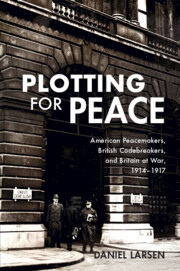Book contents
- Plotting for Peace
- Plotting for Peace
- Copyright page
- Dedication
- Contents
- Figures
- Map
- Graph and Table
- Dramatis Personae
- Preface
- Acknowledgements
- Maps
- Introduction
- 1 The First Year of War
- 2 Strategy
- 3 Negotiations
- 4 Deliberations
- 5 The Gamble
- 6 The Knock-Out Blow
- 7 The Fall of Asquith
- 8 Peace Moves
- 9 The Zimmermann Telegram and Wilson’s Move to War
- Conclusion
- Book part
- Notes
- Bibliography
- Index
1 - The First Year of War
August 1914–August 1915
Published online by Cambridge University Press: 26 March 2021
- Plotting for Peace
- Plotting for Peace
- Copyright page
- Dedication
- Contents
- Figures
- Map
- Graph and Table
- Dramatis Personae
- Preface
- Acknowledgements
- Maps
- Introduction
- 1 The First Year of War
- 2 Strategy
- 3 Negotiations
- 4 Deliberations
- 5 The Gamble
- 6 The Knock-Out Blow
- 7 The Fall of Asquith
- 8 Peace Moves
- 9 The Zimmermann Telegram and Wilson’s Move to War
- Conclusion
- Book part
- Notes
- Bibliography
- Index
Summary
Over the first year of the war, Britain moved from a position of financial power over the United States to a position of increasing economic dependency. Responsibility for managing this shift fell first to Chancellor David Lloyd George, who showed little interest in the Treasury's operations during the war, and then to Reginald McKenna, who became increasingly seized of the problem. American Colonel Edward House moved to try to mediate the war, taking a trip to Europe. Finding that it was still far too early to mediate the conflict, House set his sights much lower. He looked merely to convince the powers that, when it came time to end the war, the United States should serve as the necessary neutral clearing-house through which the negotiations would be completed. At the same time, British intelligence organization MI1(b) worked to solve the American diplomatic codebooks, succeeding not long after House returned to the United States.
- Type
- Chapter
- Information
- Plotting for PeaceAmerican Peacemakers, British Codebreakers, and Britain at War, 1914–1917, pp. 24 - 47Publisher: Cambridge University PressPrint publication year: 2021

